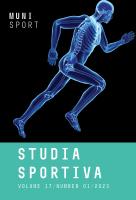Use of Rate of Force Development in Field Testing of Ice-Hockey Players
Use of Rate of Force Development in Field Testing of Ice-Hockey Players
Author(s): Jakub Krajňák, Michal KumstátSubject(s): Social Sciences, Sociology, Sports Studies
Published by: Masarykova univerzita nakladatelství
Keywords: Ice-hockey; field testing; rate of force development; RFD; velocity training
Summary/Abstract: Introduction: Ice hockey is a power-speed sport played on ice. The surface specification is very different from a normal surface, so it is important to look for the most appropriate measurements and specific off-ice tests that would better define ice-hockey performance. Therefore, the main purpose of this research was to determine the relationship of rate of force development (RFD) in back squat with commonly used off-ice and on-ice tests. Methods: The research involved 15 junior ice-hockey players (181.8 ± 4.1 cm; 80.7 ± 8.8 kg; 18.4 ± 0.9 yrs) playing in the highest competition of Czech hockey. Players performed all tests in one day divided into 2 blocks - off-ice block (OFF) in the morning and on-ice block (ON) in the afternoon, respectively. The OFF contained 30 m sprint test with 15 m split (SP15; SP30), plyometric tests (broad jump - BJ; countermovement jump - CMJ), and a velocity squat protocol (VSP). Finally, in the ON was performed speed and coordination tests - 30 m forward skating with 15 m split (FW15 and FW30); 30 m backward skating with 15 m split (BW15 and BW30); Weave agility test (WAT); Transition test (TT) and Pro-agility test (PAT). Results: No significant results were found between RFD and coordination tests (TT, WAT, PAT) and CMJ. The significant correlations were found between RFD40kg and SP30 (r = -.865; p < .01) and BJ and RFD40kg, respectively (r =.649; p < .05). However, as the back squat loads increase, the correlation strength decreases between RFD and SP30 (r = -.677; p < .01 for RFD50kg and r = -.560; p < .05 for RFD60kg). Moreover, the strong degree of correlation were observed between RFD40kg and FW15 (r = -.699; p < .05) and also FW30 (r = -.705; p < 0.05). Conclusion: The results of the study show a significant relationship between the RFD and commonly used off-ice and on-ice tests.
Journal: Studia sportiva
- Issue Year: 17/2023
- Issue No: 1
- Page Range: 108-115
- Page Count: 8
- Language: English

